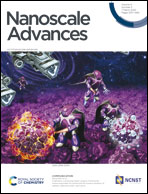SISSO-assisted prediction and design of mechanical properties of porous graphene with a uniform nanopore array†
Abstract
Mechanical properties of porous graphene can be effectively tuned by tailoring the nanopore arrangement. Knowledge of the relationship between the porous structure and overall mechanical properties is thus essential for the wide potential applications, and the existing challenge is to efficiently predict and design the mechanical properties of porous graphene due to the diverse nanopore arrangements. In this work, we report on how the SISSO (Sure Independence Screening and Sparsifying Operator) algorithm can be applied to build a bridge between the mechanical properties of porous graphene and the uniform nanopore array. We first construct a database using the strength and work of fracture calculated by large-scale molecular dynamics simulations. Then the SISSO algorithm is adopted to train a predictive model and automatically derive the optimal fitting formulae which explicitly describe the nonlinear structure–property relationships. These expressions not only enable the direct and accurate prediction of targeted properties, but also serve as a convenient and portable tool for inverse design of the porous structure. Compared with other forecasting methods including several popular machine learning algorithms, the SISSO algorithm shows its advantages in both accuracy and convenience.



 Please wait while we load your content...
Please wait while we load your content...